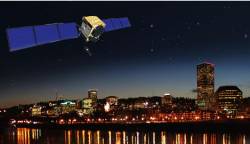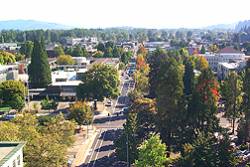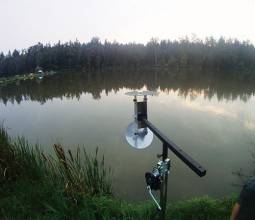 The Portland skyline with a GPSIIF satellite is featured in the Inside GNSS booth at ION GNSS 2010
The Portland skyline with a GPSIIF satellite is featured in the Inside GNSS booth at ION GNSS 2010by Glen Gibbons
Few would mistake Oregon for the beating heart of GNSS. Still, for a medium-sized U.S. metro area in the Pacific Northwest, Portland and Oregon’s I-5 corridor has enough relevant involvement with the industry to justify hosting the Institute of Navigation’s 2010 GNSS conference and exhibition.
Oregon has FLIR Systems, Cloud Cap Technology, TriQuint, Intel, Garmin and Inside GNSS magazine.
by Glen Gibbons
Few would mistake Oregon for the beating heart of GNSS. Still, for a medium-sized U.S. metro area in the Pacific Northwest, Portland and Oregon’s I-5 corridor has enough relevant involvement with the industry to justify hosting the Institute of Navigation’s 2010 GNSS conference and exhibition.
Oregon has FLIR Systems, Cloud Cap Technology, TriQuint, Intel, Garmin and Inside GNSS magazine.
And, of course, Oregon is the cradle of geocaching, the GPS-guided treasure hunt phenomenon. The first cache (or the "original GPS stash") was hidden on a tree farm right outside of Portland the day after selective availability was turned off in 2000.
FLIR Systems makes infrared and thermal-imaging systems that keep company with GPS on autonomous unmanned aerial ehicles (UAVs). They’re an S&P 500 company based in Wilsonville, just south of Portland.
Amd speaking of UAVs, Cloud Cap Technology, a Goodrich company that develops autopilots, GPS/INS payloads, flight management systems and miniaturized cameras for UAV and other autnomous platforms, is 60 miles east of Portland in Hood River, Oregon. (That’s the center of another Oregon homegrown activity, Columbia River windsurfing.)
Although it’s not based in Oregon, Intel Corporation has a major presence in the state’s "Silicon Forest" west of Portland. Facilities there include a significant research center with about 475 staff members as well as manufacturing plants.
Intel has a long history developing products and applications that work with GPS and other location technologies. In January, the company introduced LocationTechnologies Software Development Kit 1.0,which provides a location identification engine and a location
identification API to work across Intel mobile platforms, using multiple location data sources.
TriQuint Semiconductor, another hi-tech company, manufactures some of those tiny electronic components that go into GPS receivers and other mobile devices such as RM front-end modules that incorporate a low noise amplifier and filter at the GPS L1 frequency.
TriQuint celebrated its 25th anniversary this year and reported first quarter revenue just under $200 million, up 52% from a year earlier. Earlier this year the company put out a call for RF design and applications engineers for positions in a number of locations, including Boston and Orlando as well as Portland.
GPS receiver manufacturer Garmin International — a favorite among geocachers for their portable navigation devices — operates Garmin AT in Salem, Oregon. Originally established as II Morrow, an independent avionics manufacturers, the Salem facility later provided key package delivery and tracking technologies as a UPS Technologies company.
Named after founders Gary Burrell and Min Kao, GARMIN has another round-about connection to Oregon: the King Estate Vineyard winery in Lane County, established by Ed King III. King III is the son of Ed King Jr., the founder of the original King Radio avionics company in Olathe, Kansas, later acquired by the Bendix Corporation/Allied Signal (and now a part of Honeywell).
In any case, Burrell hired Kao to join his division at Allied Signal’s King subsidiary in 1983. Kao had been working at Magnavox developing military navigation systems using the Global Positioning System constellation of satellites. During his years working with Burrell, Kao led the team that developed the first GPS navigation system that was to be certified for use in airplanes by the U.S. Federal Aviation Administration. (Okay, a tenuous connection, but kind of interesting.)
And, finally, there’s us: Inside GNSS. Both of the industry’s leading trade journals, Inside GNSS and GPS World, got their start 100 miles down the I-5 freeway from Portland in college-town Eugene.





